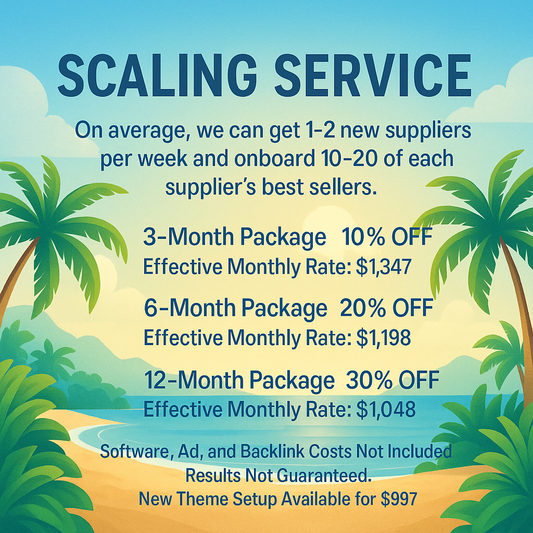
Unlock Ecommerce Success with Google Analytics Insights
Hey there, ecommerce enthusiasts! Trevor Fenner here, founder of Ecommerce Paradise. If you're running an online store and looking to amplify your marketing efforts, understanding Google Analytics is a game-changer. In this post, we’ll dive deep into how leveraging Google Analytics can elevate your Ecommerce SEO, optimize your Google Shopping Ads, and improve your Email Marketing strategies. Buckle up—we're going on a journey through the realm of data!
What is Google Analytics?
First things first, let’s clarify what Google Analytics (GA) is all about. It's a powerful tool that helps you monitor and analyze your website traffic. You can track visitor behavior, see where your traffic is coming from, and understand how users interact with your site. This free tool offers insights that are essential for refining your SEO strategies and driving better performance in your ecommerce store.
Setting Up Google Analytics
If you’re ready to take your Shopify store to the next level, the first step is to set up your Google Analytics account. Here’s a quick, straightforward guide to get you started:
- Create a Google Account: If you don’t have one, go ahead and create your Google account.
- Sign Up for Google Analytics: Visit the Google Analytics website and sign up.
- Add Your Website: Enter your website details, including your Shopify store URL.
- Install Tracking Code: Google will provide you with a tracking code. You can add this to your Shopify theme or use a app to make it easier.
- Verify Your Setup: Use the real-time report in Google Analytics to ensure that your tracking is working correctly.
Understanding Key Metrics for Ecommerce SEO
Now that you've set up Google Analytics, let’s explore the key metrics you should be paying attention to for enhancing your Ecommerce SEO. These metrics not only help in driving traffic but also support your efforts on platforms like Google Shopping Ads and Email Marketing.
Sessions and Users
Sessions represent the number of times users visit your website, while users show how many distinct visitors you have. Tracking these metrics helps you gauge your website's overall performance and the effectiveness of your SEO efforts. You can analyze trends over time to see if changes in your strategies lead to an uptick in visitors.
Bounce Rate
The bounce rate indicates the percentage of users who leave your site after viewing only one page. A high bounce rate can suggest that your landing pages need improvement. Using Google Analytics, you can identify pages with high bounce rates and make adjustments to enhance user engagement.
Conversion Rate
The conversion rate is a crucial metric that shows the percentage of users who take a desired action—be it making a purchase, signing up for a newsletter, or reaching out for inquiries. Improving your conversion rate should be your primary focus, and using Google Analytics will help you understand where visitors drop off in the sales funnel. This insight is vital for optimizing your product pages for Ecommerce SEO.
Source/Medium
Knowing where your traffic originates—be it organic search, paid ads, or social media—can offer invaluable insights. This data enables you to put more emphasis on successful channels while optimizing others. If you find that Google Shopping Ads are bringing in significant traffic but have a low conversion rate, then you may need to reevaluate your product listings or targeting strategies.
Utilizing Google Analytics for SEO Enhancements
So how do you actually use the data gathered from Google Analytics to boost your SEO? Let’s break it down.
Conducting Keyword Research
Although Google Analytics doesn’t provide specific keyword data, you’ll still gain insights from Google Search Console. By linking your GA account with Search Console, you can see which keywords are driving organic traffic. This information is helpful for tailoring your content, optimizing product descriptions, and ultimately improving your Ecommerce SEO.
Evaluate Landing Pages
Your landing pages are crucial for conversions. Use GA to identify which pages keep users engaged and which ones fail to capture interest. Look at metrics like average session duration and bounce rate. Optimize poorly-performing pages by improving content quality, adding better CTAs, or enhancing usability. Always think of the user journey to increase conversion rates.
Enhancing User Experience
Google places significant weight on user experience, which is a crucial part of SEO. Use GA’s data on page load times and site speed to refine your website. If you notice high bounce rates tied to long load times, it’s essential to optimize images, eliminate unnecessary scripts, and streamline your design. A swift website not only pleases users but also boosts your SEO ranking.
Strategizing Your Email Marketing
How does Google Analytics tie into your Email Marketing efforts? By analyzing traffic from your email campaigns in GA, you can determine which emails drive engagement, conversions, and sales. Use UTM parameters on your links to track campaign performance. You will gain insights into open rates, click rates, and overall effectiveness. This data allows you to refine your email strategies, segment your audience better, and optimize your Ecommerce SEO to enhance visibility.
Integrating Google Shopping Ads with Google Analytics
Google Shopping Ads can be an excellent source of traffic and sales for your Shopify store. Here's how Google Analytics plays a role:
Tracking Ad Performance
Google Analytics allows you to monitor the performance of your Google Shopping Ads. You can track metrics like traffic, conversion rates, and overall ROI of your ads. By understanding which ads perform best, you can adjust your campaigns accordingly. Focus on keywords and product images that attract users, as improving these areas can help boost your SEO.
Optimizing Product Listings
One key aspect of your Google Shopping Ads is optimizing product listings. Use insights from GA to fine-tune your product titles, descriptions, and images. If certain listings drive organic traffic, it may be time to consider increasing their visibility through Google Ads. The data will help you make informed decisions on your investments for the best outcome.
Making Data-Driven Decisions
All the data from Google Analytics is fantastic, but the real magic happens when you use this information to make data-driven decisions. Here are some ways you can apply these insights effectively:
- Experiment: Don’t be afraid to test different approaches to your Ecommerce SEO strategy. Use GA data to run A/B tests on landing pages, email campaigns, and ad creatives.
- Set Goals: Utilize Google Analytics to set conversion goals specific to your business. It could be sign-ups, purchases, or reaching a particular page. Monitor your progress regularly.
- Analyze Competitors: While GA gives you insights on your own site, competitor analysis is vital as well. Follow industry trends and see how your performance stacks up against others.
Future-Proofing Your Ecommerce Strategies
The world of ecommerce is continually evolving, and so should your strategies. As a dropshipping entrepreneur, you need to stay ahead of trends, and Google Analytics will help you do just that. By harnessing the insights gained from analytics, you'll be well-equipped to refine your SEO tactics and adjust your marketing strategies based on what the data tells you.
Embrace New Technologies
As new technologies pop up, it’s essential to integrate them into your strategies. Voice search, chatbots, and machine learning can all influence how you approach your ecommerce store. Stay current and adaptable, using data as your guiding light.
Keep Learning
The ecommerce landscape is ever-changing. Keep yourself informed about new features in Google Analytics and how to leverage them effectively. With online resources, webinars, and forums, you can continuously improve your knowledge and implement advanced tactics to enhance your Ecommerce SEO.
Final Thoughts: Empower Your Ecommerce Journey
Getting to grips with Google Analytics might seem daunting at first, but trust me—it’s worth your time. By diving deep into the data, you’re not just looking at numbers; you’re uncovering actionable insights that can transform your business landscape. So, get familiar with your analytics, embrace the changes, and let your ecommerce store thrive! Here at Ecommerce Paradise, I’m rooting for your success!


















